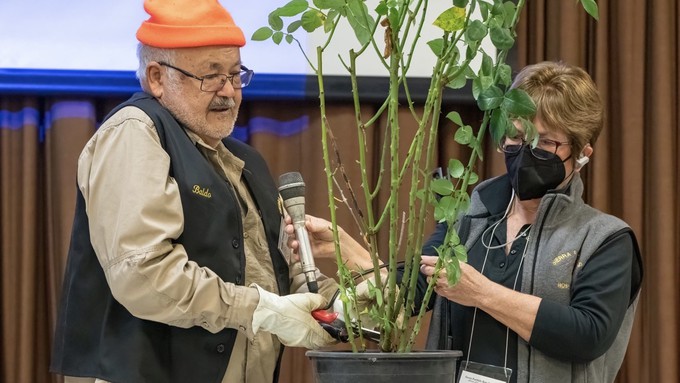
Warmer weather brings out rapid rose growth

Baldo Villegas demonstrates his 3-minute rose-pruning method at a 2022 workshop. At right is fellow rosarian Charlotte Owendyk. Photo courtesy Sierra Foothills Rose Society
It’s almost the end of January and I’m facing another deadline – completion of my annual rose pruning. And this time, Mother Nature is putting on the pressure.
Our winter deluge – nearly three consecutive weeks of rain – put me way behind in this yearly chore. Before Christmas, it was so warm and dry, my roses kept blooming – so I kept procrastinating. (It was the holidays; I had things to do I liked more than tangling with prickly bushes.) After Christmas, it did nothing but rain.
I’m not alone in this predicament; many gardeners are trying to beat the calendar – or growth hormones.
Sacramento rose lovers try to get our bushes pruned before Valentine’s Day. It’s a semi-arbitrary deadline; roses are dormant during the chilly winter months and a lot easier to prune. Roses start growing again as soon as the weather warms, usually after a round of deep-soaking rain. That combination usually hits sometime in late February or early March.
Our January storms were not only wet (and deep soaking), but warm. Afternoon temperatures have been edging close to 70 degrees. And that prematurely woke up my roses. Suddenly, I had bud breaks and new growth everywhere – and a real mess.
I squeezed a little pruning in between storms, but it was mostly to bushes adjacent to firm footing on the patio or driveway. Finally, the ground in my garden was dry enough this week for me to plunge into serious pruning; 120 bushes done and 20 to go.
How did I get through so many roses so quickly? I kept remembering Baldo’s three-minute method.
Baldo Villegas, best known as Sacramento’s Bug Man, is a retired state entomologist and master rosarian. He also grows a tremendous number of roses – about 3,000 bushes. To tackle that many plants, Baldo came up with a strategy: Start from the bottom. Look at the base of the plant, determine what canes to keep and what to cut. Then, go for it.
Often, you’ll need to start at the top, too, especially if it’s a very large bush. Cut the rose down nearly to the height it should be when blooming (usually 4 feet tall for hybrid teas). Then, sort out the canes.
Baldo’s method simplifies the process of rejuvenating the plant. Pruning back to the same points year after year does not make good roses; it shortens the life of the plant and limits its growth. By focusing on strong, healthy, younger canes, pruning allows those “keeper” canes to flourish – and flower more.
Baldo recently explained his method during the Sierra Foothills Rose Society’s annual winter rose care workshop. The podcast team from Green Acres Nursery & Supply was on hand to record Baldo in action and get his tips.
“These rose pros share their best methods for pruning, and a few safety tips while working with these prickly plants,” says Green Acres. “With some goatskin gloves, and Baldo’s bottom-to-top technique, you’ll be pruning like a master rosarian in no time.”
Listen to the podcast here: https://www.buzzsprout.com/1610311/12058108-winter-care-for-roses.
Comments
0 comments have been posted.Sacramento Digs Gardening to your inbox.
Sites We Like
Garden Checklist for week of April 21
This week there’s plenty to keep gardeners busy. With no rain in the immediate forecast, remember to irrigate any new transplants.
* Weed, weed, weed! Get them before they flower and go to seed.
* April is the last chance to plant citrus trees such as dwarf orange, lemon and kumquat. These trees also look good in landscaping and provide fresh fruit in winter.
* Smell orange blossoms? Feed citrus trees with a low dose of balanced fertilizer (such as 10-10-10) during bloom to help set fruit. Keep an eye out for ants.
* Apply slow-release fertilizer to the lawn.
* Thoroughly clean debris from the bottom of outdoor ponds or fountains.
* Spring brings a flush of rapid growth, and that means your garden is really hungry. Feed shrubs and trees with a slow-release fertilizer. Or mulch with a 1-inch layer of compost.
* Azaleas and camellias looking a little yellow? If leaves are turning yellow between the veins, give them a boost with chelated iron.
* Trim dead flowers but not leaves from spring-flowering bulbs such as daffodils and tulips. Those leaves gather energy to create next year's flowers. Also, give the bulbs a fertilizer boost after bloom.
* Pinch chrysanthemums back to 12 inches for fall flowers. Cut old stems to the ground.
* Mulch around plants to conserve moisture and control weeds.
* From seed, plant beans, beets, cantaloupes, carrots, corn, cucumbers, melons, radishes and squash.
* Plant onion sets.
* In the flower garden, plant seeds for asters, cosmos, celosia, marigolds, salvia, sunflowers and zinnias.
* Transplant petunias, zinnias, geraniums and other summer bloomers.
* Plant perennials and dahlia tubers for summer bloom.
* Mid to late April is about the last chance to plant summer bulbs, such as gladiolus and tuberous begonias.
* Transplant lettuce seedlings. Choose varieties that mature quickly such as loose leaf.